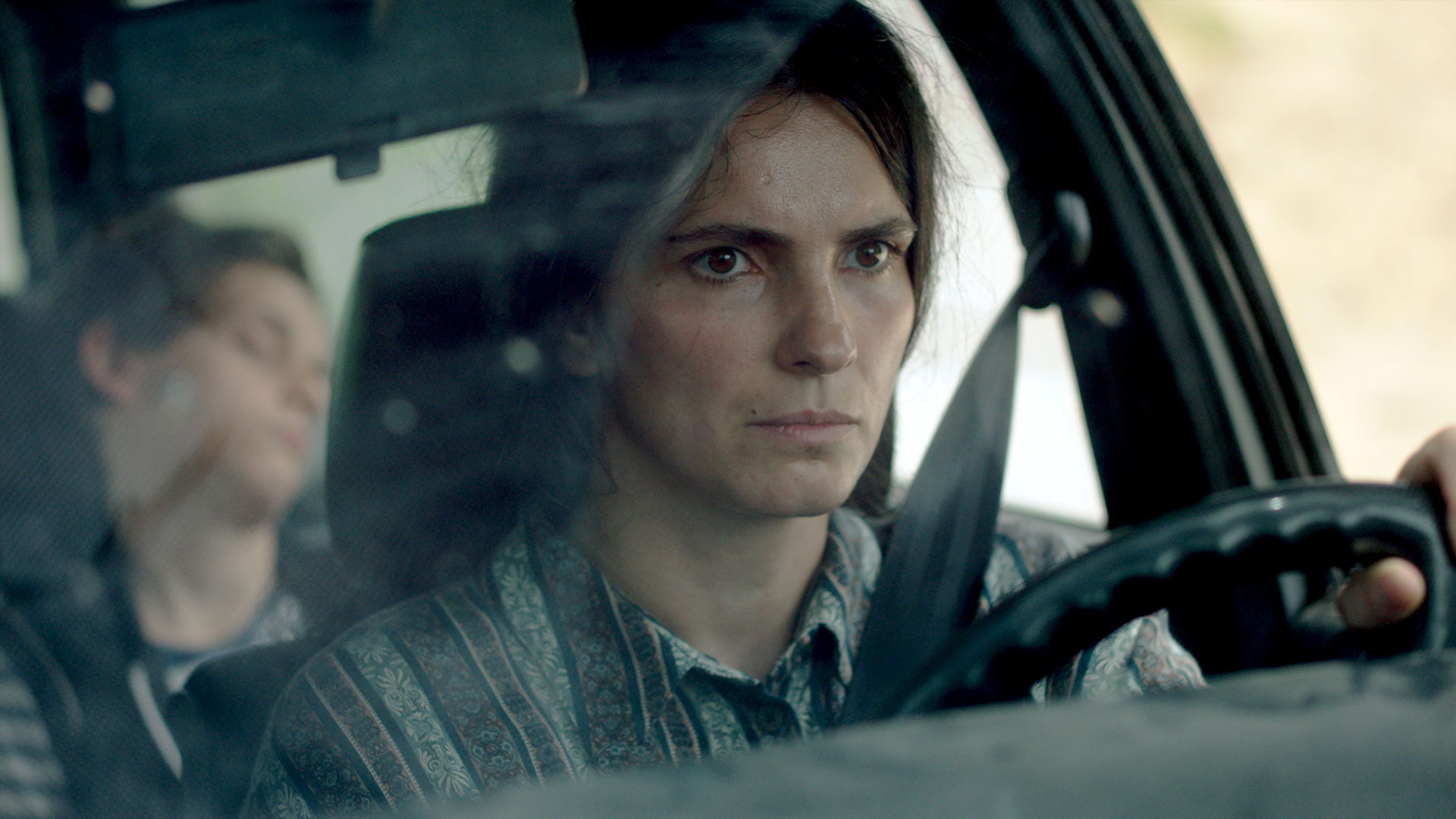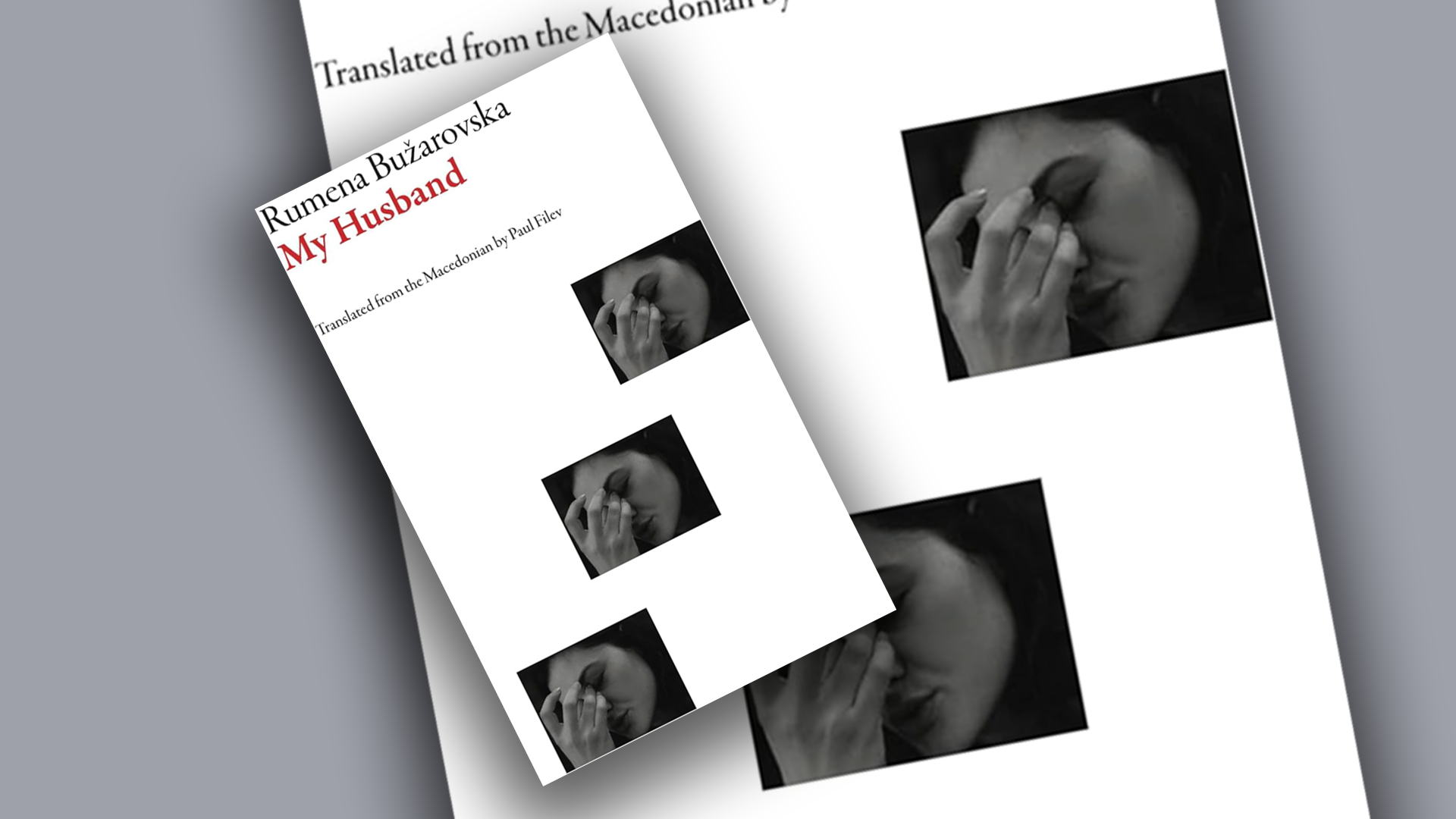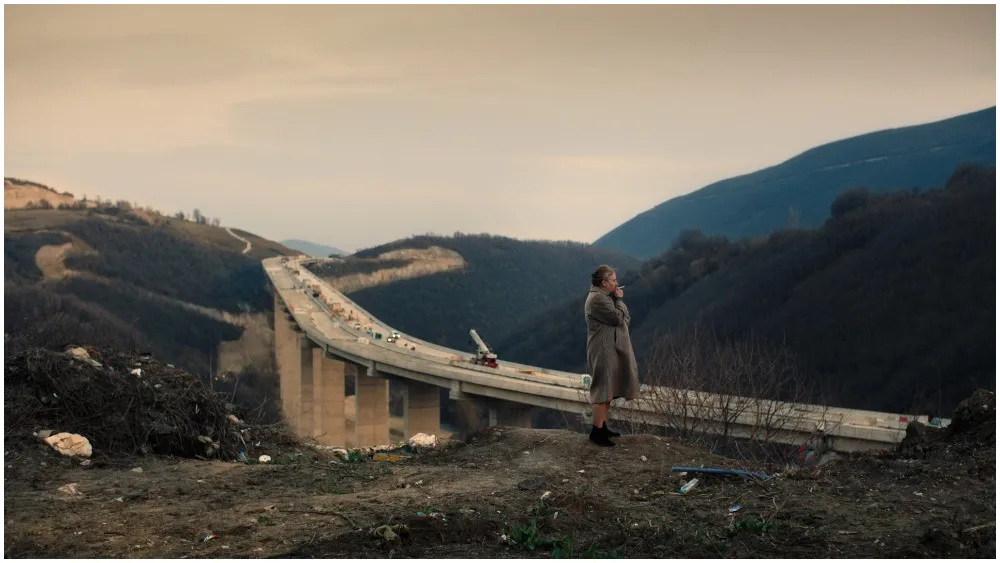Ever since I watched Blerta Basholli’s masterpiece “Hive,” I’ve been eager to find more media whose portrayal of women gives me the same feeling of familiarity I felt while watching it. In “Hive,” Yllka Gashi plays Fahrije, a widow who starts selling ajvar and honey to support her family after her husband went missing during the 1999 Kosovo war.
Aside from the film’s excellent representation of Kosovar women attempting to re-build their community after the war, Gashi’s performance moved me because it put a mirror in front of me. Fahrije was me; she was all the women in my life. I saw myself in her stern expression, the sweat on her forehead and the roughness of her fingertips. Her hopeless resignation in the face of her bleak reality is what made her feel so close, as if she was a woman I know. I thought she was beautiful, resilient and most importantly, real.

Fahrije’s determination and resilience make her a recognizable and relatable protagonist. Still from the movie “HIVE”
Searching for similar media, I came across a compilation of “65 essential feminist movies.” Unsurprisingly, the list consists of films like “Promising Young Woman,” “Wonder Woman,” “Nine to Five,” “Clueless,” “Erin Brokovich,” and “Legally Blonde.” This collection was published in 2022, so it did not incorporate “Barbie,” which was celebrated as a “feminist bimbo classic” upon its release in 2023.
While the plots of these films incorporate themes of women empowerment and center female protagonists, their feminist branding is a hollow marketing ploy echoed by uncritical media outlets. Their vaguely empowering narratives may appear compelling, but their unrealistic depictions of a perfect feminist heroine only exacerbate the issue of superficial female characters.
Shallow and one-dimensional female characters
In true Hollywood fashion, the protagonists are thin and conventionally attractive women who are flawless from every angle. They’re strong, working women who are successful against the odds; they’re just feminist enough to be palatable to liberal audiences, but they do not radically challenge systems of misogyny. In fact, they fully adhere to beauty standards and heteronormative conventions, catering to viewers’ internalized patriarchal beliefs about what a woman should look and act like. If these female characters actually deviated from misogynistic norms, even open-minded audiences would find them disagreeable and undesirable.
If these female characters actually deviated from misogynistic norms, even open-minded audiences would find them disagreeable and undesirable.
Although the depictions of these women may not be inherently damaging, the way they are branded as “essential” to feminist media is concerning. Articles by magazines with large readerships such as Seventeen, Cosmopolitan and Time Out categorize films like “The Devil Wears Prada” and even “Star Wars: The Last Jedi” as being among the “best feminist movies.” The former is about a woman who embraces beauty standards to conquer her workplace’s social hierarchy, and the latter depicts a shallow female character whose only role is as an ancillary love interest for the male heroes.
Influential U.S production studios cannot create a truly feminist film if they are afraid to depict a woman with blemishes on her skin, let alone a multi-faceted, complex woman unafraid of being unpleasant — a real woman, like the ones in our own lives, who are probably not freedom fighters with gel manicures.
When it comes to female characters, the issue of realism is also one of humanization. We now have progressive female protagonists who are openly feminist and independent, but they lack recognizable humanity. The list described above includes both fictional stories and adaptations of true stories, yet even the protagonists based on actual women’s lives still don’t feel real.
The feminist heroine trope is yet another unreachable aspiration, a woman who is always brave, heroic, and powerful, no matter the circumstances against her. She is always willing to fight patriarchy with a sword and shield, either metaphorically or literally. At her core, the feminist heroine is an ideal woman created to check all the boxes.
The list of requirements is long: Are you beautiful? Are you strong? Are you independent to the point where you don’t need help from anyone else, ever? Do you maintain the perfect physique while also being a corporate girlboss? It seems that these depictions only increase expectations for the women we should be, while hardly being representative of the women we are. Production companies are still afraid to tell stories about women who are not attractive or likable enough to generate box office revenue, revealing our collective aversion to humanized women.
Balkan women storytellers
Unlike Hollywood’s depiction of the feminist heroine, the woman storytellers of the Balkans show audiences the harrowing underbelly of female experience. As in “Hive,” the Kosovar film “Vera Dreams of the Sea” and the Bosnian film “Quo Vadis, Aida?” portray female protagonists who often accept their grim situations and subsequently make questionable moral decisions.
Unlike Hollywood’s depiction of the feminist heroine, the woman storytellers of the Balkans show audiences the harrowing underbelly of female experience.
The Macedonian documentary “Honeyland” depicts the life of a female beekeeper, Hatidže, for who she really is, in all her agency and capable, working hands. Rumena Buzarovska, author of the short story collection “My Husband,” said that she has often been criticized for the defeatism of her female characters. Her decision to represent real women living in patriarchal societies, and the actual ways in which they respond to their conditions, is refreshing and courageous: “I like to present these conditions, realistically, because it’s a way of criticizing them,” said Buzharovska.

Rumena Buzarovska sees her realistic portrayals of female characters as criticism of the conditions faced by women. Photo Credit K2.0.
Hollywood directors saw that all the heroes were men and assumed the issue was the lack of female heroines. This fueled their motivation for creating empowering stories, which wrongly assumed the need for strong and powerful female characters analogous to the widely celebrated male personalities in superhero films. But the problem with male-dominated media was always a lack of realistic female representation, not a shortage of superwomen.
Conversely, Balkan female storytellers observe and reveal real women’s lives rather than mythologize women’s experiences and turn them into epics. In a region where women’s stories have historically been labeled unimportant and ignored, Balkan female storytellers unveil impactful female narratives that have often taken place in recorded history’s shadowy background.
These storytellers show us the value of the quiet and mundane private sphere Balkan women have been forced to inhabit. Most importantly, they’re proving that unheroic stories can still be powerful, as they authentically represent women we recognize and the familiar struggles faced by women in this region. The portrayal of regular women and their everyday challenges can catalyze a collective acknowledgement of our severe conditions. Only by fully recognizing our current reality can we begin to imagine alternative futures.
Only by fully recognizing our current reality can we begin to imagine alternative futures.
The trouble with individualist feminism
The feminist heroine character is indicative of a troubling trend in modern feminism, one that celebrates individualism and personal willpower as tools for fighting patriarchal systems. This neoliberal phenomenon of girlboss feminism encourages the empowerment model used in Hollywood films, where the message — I can do it, so can you — idealizes an exceptional and unrelatable female protagonist.
The logical conclusion of such narratives is that feminism’s end goal is ascending capitalist ladders and power structures. It envisions empowering women in the same institutions that presently exist rather than proposing a radical shift away from these patriarchal institutions altogether. A story about women beating men at their own game is not revolutionary or feminist, as the game itself is inherently flawed and harmful.
Even with financial independence, Balkan women suffer from systemic violence that makes it impossible to integrate into a masculinized society. The external worlds of Fahrije, Vera, Aida, Hatidže, and the wives in Buzharovska’s stories are invaded by men: men in city streets, men in tea shops, men in professional spaces, men in war. Once these protagonists step out of female domesticity and enter the lively arenas of men, it is as though their worlds become infested by a swarm of bees, warning them with each sting. We get a sense that these women are not supposed to be there and that they are entirely unwelcome.

Protagonists such as Vera live relatable and recognizable lives in the face of deeply-rooted patriarchy. Still from the movie “Vera Dreams of the Sea.”
In “Nectar,” Buzharovska writes from the perspective of a wife with a gynecologist husband: “All of his friends are also doctors, whom he met at university, and whose wives have now become his patients. Together they form a ‘boys’ club’ … I have a terrible, sinking suspicion, which I’m afraid to put into words, and that is that his friends deliberately take their wives to see my husband, because in that way they have control over them.” This depiction of Balkan society through the eyes of women emphasizes the usage of violence and fear to maintain this “boys club,” where the control exerted over women infringes on their personhood and autonomy.
Contrary to the narratives of girlboss feminism, the Balkan woman’s struggle does not only lie in the fact that she is undervalued in professional settings. Labor, even physical, has been expected of Balkan women for generations. Instead, their fundamental struggle lies in the fact that while being expected to work, they are also met with physical and sexual violence, humiliation and public shaming. Simultaneously, they are required to raise children, prepare meals, complete unpaid housework and take care of the elderly. These struggles are not unique to the Balkans, but present an entirely different reality to that of the Western women portrayed in Hollywood films.
These struggles are not unique to the Balkans, but present an entirely different reality to that of the Western women portrayed in Hollywood films.
In the last three years, 162 women have been killed by femicide in the Western Balkans. It’s doubtful that Wonder Woman or Barbie could mend a society where women still fear for their lives solely because they are women. Only raw and vulnerable depictions of everyday women, with all their flaws, can paint the complex picture of our realities. By exposing the tragedy and pain, change and growth can finally occur. The Balkan version of a feminist heroine is not a heroine at all. She is just a woman, and that is brave enough.
Feature Image: K2.0.

This blog was published with the financial support of the European Union as part of the project “Diversifying voices in journalism.” Its contents are the sole responsibility of Kosovo 2.0 and do not necessarily reflect the views of the European Union.





